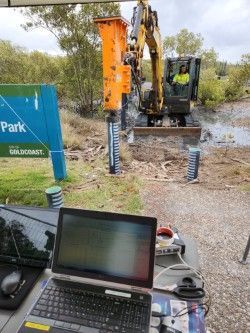Unlocking the future of Australia’s critical infrastructure: are composites the key?
Above: Dr Ali Mohammed - Wagners CFT Technical Lead, Luke Preston - ACM CRC CTO, Dr Stephen van Duin - ACM CRC R&D Director, Dr Steve Gower - ACM CRC CEO, John Dignam -Wagners CFT Executive Director.
If we truly want a Net Zero Future, then we need to closely consider the effective design of resilient infrastructure for long-term service. One ACM CRC project is doing just that, focusing on the advanced construction materials used in marine environments, and investigating how composites could change the way we build.
Maritime infrastructure built along the Australian coast is experiencing early deterioration and premature failure from the biological degradation of timber, corrosion of steel reinforcements, and the expensive cost thus lack of maintenance. The ongoing replacement of these maritime infrastructure costs the Queensland Government at least $10 million per annum (Manalo et al. 2021).
To prevent this figure from increasing (with Australia becoming more susceptible to climate-induced weather events), a collaborative industry-led research team is investigating high performance and low-carbon emission composite materials as effective solutions to build resilience of maritime infrastructure against natural disasters.
The ACM CRC project is being undertaken by regional partners Wagners Composite Fibre Technologies (CFT)(Wagners CFT) and the University of Southern Queensland (UniSQ), together with end-user, the Maritime Safety Queensland (MSQ) of the Queensland Department of Transport and Main Roads (TMR). They’re seeking to eliminate the significant problem of early deterioration and premature failure of traditional construction materials in marine environment, and unlock the potential of advanced fibre composites for climate-resilient maritime infrastructures.

“We believe high-performance Fibre-Reinforced Polymer (FRP) composites have potential for exponential growth in maritime infrastructure,” said Professor Allan Manalo, Director of the Centre for Future Materials at UniSQ. “Through this project, we’re wanting to gain more knowledge on their structural performance against imposed hydrodynamic loads, and on their long-term performance against the aggressive marine environment.”
The devastating flooding experienced by Queensland and NSW in 2022 claimed an estimated $492 million worth of critical public infrastructure damage, as reported by the Queensland Reconstruction Authority (2022). The project team are hoping their efforts will help improve the longevity of Australia’s critical infrastructure, and deliver a safer, more environmentally friendly, and more economical solution through the use of composite building materials.
“We are very interested in the practical application of the research outcomes,” said Mr Ryan Leeson, Regional Manager at Wagners CFT. “The adaptive composite solutions could open doors for TMR – as well as other transport authorities in Australia – to design, build and deliver infrastructure and transport systems that are better able to withstand the adverse impacts of increasing natural disasters,” he said.
“Wagners CFT, UniSQ and MSQ have, together, successfully delivered new and transformative polymer composite technologies across several infrastructure projects,” added Dr Steve Gower, CEO at ACM CRC. “We are excited by this project’s potential, particularly the potential for acceptance and implementation of composites in maritime and other infrastructure, for a safer, more carbon considerate Australia,” he concluded.
See what else is happening in and around ACM CRC: View other projects.




